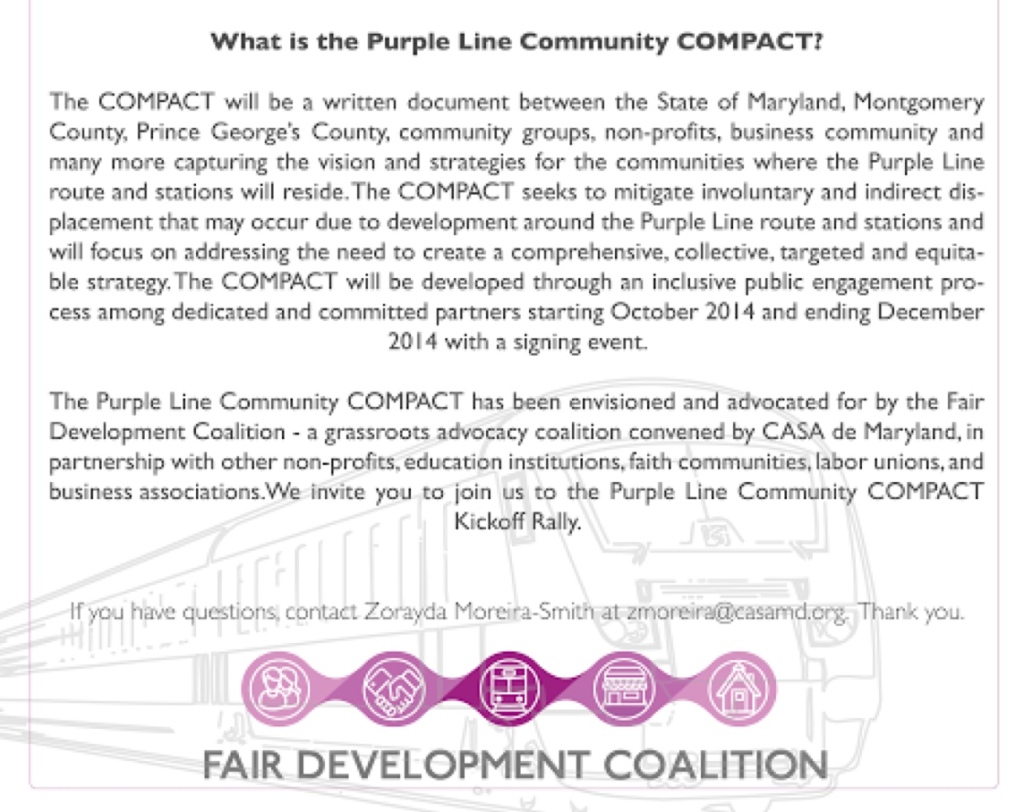Last week, I published a blog post on the conundrums facing the Purple Line Compact effort to preserving affordable housing and commercial rents in areas around new Purple Line stations. At the end of the piece, I wrote that I’d welcome hearing more from Compact proponents about “creative ideas to ease the collision of fundamental economic forces with real social needs.” I appreciate that Maryann Dillon, Executive Director of the Housing Initiative Partnership, took up this public invitation. Here are her thoughts:
In his article on October 2, “Fair Development Compact Pipe Dream”, David Lublin rightly argues that a “central goal of the Purple Line is to improve transportation connections” and that, as a result, “the land around the stations should become more desirable and valuable”.
He cites Bethesda, Silver Spring, Ballston and Clarendon as successful examples of places that have become more desirable given their access to transportation including Metro. These places boast stronger tax bases that help local governments provide better services. I think we all can agree that these are four of the most desirable and attractive destinations in the DC metro area, and that, as a result, they naturally have increased in value.
What David fails to note, however, is that all four of these locations are beneficiaries of progressive housing policies by the Montgomery and Arlington County governments put in place well before revitalization occurred.
Forty years ago, Montgomery County pioneered the concept of “inclusionary zoning”. Called Moderately Priced Dwelling Units (MPDUs), Montgomery County’s program requires developers of over 20 residential units to include 12.5% of the units as affordable to working families earning less than 80% area median income ($85,600 for a family of four). The MPDU program has created thousands of homes affordable to moderate income renters and homebuyers scattered in every neighborhood of the County. In this way, a broader range of residents can live near transportation and jobs, reducing the burdens on our roads from long-distance commutes. A mix of housing types makes it easier for employers to find workers for their restaurants, hotels, offices and local services that make these communities special, let alone the teachers, fire and police personnel necessary to maintain their high quality of life. Montgomery County commits around $50 million annually from its own general revenue to support affordable housing development in its most desirable communities.
Likewise, the Arlington County Affordable Housing Ordinance offers developers seeking additional density in the site plan process the choice of providing affordable units or contributing to the Affordable Housing Investment Fund. The Special Affordable Housing Protection District (SAHPD) as outlined in the General Land Use Plan identifies existing affordable housing sites within the County’s two Metro Corridors that are planned for site plan projects of 3.24 FAR or higher. Existing affordable housing units are to be replaced on a one-for-one basis, again with the goal of protecting and preserving the mix of housing types and prices that can help keep these corridors dynamic and diverse. Arlington has committed $13 million in the current fiscal year to support its Affordable Housing Investment Fund.
Last year, the Prince George’s County Council passed inclusionary zoning legislation and charged the County Executive with recommending areas of the County in which this zoning would apply. While the recommendations have been made, County Council has not yet taken any action on them. Unlike its neighbors, Prince George’s County does not dedicate any of its own resources to develop or renovate affordable housing.
On August 30, 2014, the Washington Post published a story, “Affordable rents fading away in DC’s housing picture” which described the imbalance between the overbuilt “luxury” rental market and the continued loss of more affordable and moderately prices apartments. Montgomery and Prince George’s Counties share the distinction of having 50% of their renters “cost burdened”, where they spend more than 50% of their gross income on rent. Another surprise… both the District and Montgomery County have a higher number of households earning less than 50% of the area median income than does Prince George’s County, despite perceptions to the contrary.
Surely we all understand that the Purple Line will be an economic boost for the neighborhoods along its way. But, as higher density is introduced into some of these redevelopment corridors, our State and Counties should take measures to protect the residents and small businesses that have kept many of these areas thriving, despite the lack of investment in properties for so many years. These residents kept the faith in the bad years. They should share in the rewards once the good years finally come.



